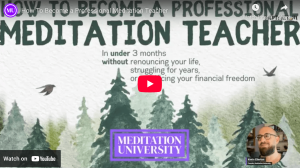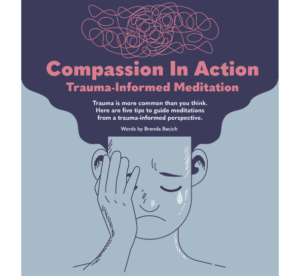As a Certified Trauma Therapist, Advanced Grief and Loss Specialist, and Clinical Supervisor, I have walked with clients through times of pain, healing and growth.
Early in my career, I would often carry stories of suffering into my home, and they would influence my mood and outlook. This led to burnout, anxiety, stress, and even resentment toward my responsibilities at work. I was headed in a dark direction, and I knew that I needed a change.
I first discovered meditation through a Wii game (remember those?). My interest was piqued, and I began reading as much as I could. I combed through the empirical evidence, and dove into meditation’s philosophies and techniques.
Since that time, I have developed a regular meditation practice, and my life has become much brighter, happier, and healthier.
Meditation has given me increased mental stability and clarity, so I thought it could also be beneficial for my clients. I decided to take Meditation Magazine’s 200-hour Meditation Teacher Training (MTT-200), and it has been very helpful in integrating meditation into my practice as a Licensed Professional Counselor.
Here are seven steps that you can follow in order to integrate meditation into your own counseling practice. I hope it is as beneficial to you and your clients as it has been to me and mine.
7 Steps to Integrating Meditation Into Your Counseling Practice
1. Develop your own personal meditation practice.
The essential first step to introducing meditation to our clients is to develop your own personal meditation practice.
Patients can spot insincerity in us a mile away. Since meditation changes us as practitioners, having our own personal practices can help us be more authentic in sharing information with our patients about the benefits that they may experience. We can speak from sincere experience, and share some of how it has benefited us personally.
Being grounded in your own personal practice will also help you understand the challenges that patients will face during their own meditation sessions, so that you can answer their questions and guide them effectively.
Lastly, when we guide clients in meditation, their states of consciousness are influenced by our own. By being deeply immersed in the present moment, we are able to guide clients more effectively into the present moment as well.
2. Create a comfortable space.
Create a space of physical comfort in your office. Consider bringing in lamps for softer lighting, allowing you to turn off the overhead lights while leading clients in meditation. Have books and references to meditation in your space. If it resonates with you, have a means of providing some soft and calming music that can play in the background.
3. Develop your teaching skills & confidence.
Practice your meditations ahead of time – both internally and out loud, by yourself and guiding others – in order to develop your skills and build your confidence.
You do not have to memorize meditations, but you’ll want to be familiar and comfortable with how guided meditations are generally worded. A smooth and confident presenting voice helps avoid sounding as if you are reading from a script or reciting from memory.
Record yourself so you can experience your own voice and identify areas for yourself that you want to improve.
Share your meditations with friends, family members, colleagues, or other meditation teachers, and ask for feedback on the experience to inform you of things you are doing well and areas you will want to fine-tune.
Finally, find comfort in silence within the meditation. Thirty seconds can feel like thirty minutes, but we need to feel comfortable with silence in order to avoid rushing through.
4. Know your science.
Know your science inside, outside and upside down. Many people still think of meditation as “woo-woo.” Many of our clients have been conditioned in a society that has taught them that they must be “doing” something to help themselves recover, and resist meditation because they view it as “passive.” Be prepared with scientific research to share, along with handouts and videos for them to view.
Be open and honest, and prepared to answer questions. Consider which types of meditation best suit the individual client.
Often, clients will need time to process the idea of meditating before giving it a try. Acknowledge, normalize and validate that it is outside their comfort zone and do not take them to a place outside your expertise.
5. Be ready for ‘Busy Brains.’
Be prepared with your response to “I have tried meditation before, and it doesn’t work for me. I can’t get my mind to a blank place.”
The response I give is paraphrased as follows:
“Our minds were designed to think. That is literally the mind’s job. To ask the mind to suddenly stop the stream of thoughts is nearly impossible. Our brains jump from one thing to another without a moment of delay. And when we find ourselves in a space of quiet, we tend to fill it with TV, radio or our phones. Few of us know how to be still and quiet and allow ourselves space. So, the only thing we will do at first is become quiet, and breathe, and when we are distracted by any thought, we will return our focus to our breath.”
6. Understand your audience.
Know the struggles your patients are facing. Acknowledge that they may not be in a place to benefit from meditation – yet. For example, some diagnoses and unhealed trauma may not be able to get the full benefits from meditation practices until they are more stable with tools to self-regulate. We know that not every person or struggle benefits from every intervention- use that knowledge to guide you on which patients may (or may not) benefit from meditation practices.
7. Seek education to deepen your knowledge & increase your confidence.
Consider joining a Meditation Teacher Certification program.
Education helps build our knowledge, competence, and confidence. Certification adds credibility to our skills and experience.
While meditation is a personal practice, teaching meditation (especially when working with clinical patients) is a skill that must be learned, practiced and developed.
Be sure to choose a reputable meditation certification class and avoid the ones that “certify” after an 8-hour class.
While we can learn beneficial information in such courses, we know it takes time and exposure to become proficient in something new. Therefore, if you are certified, continue to seek education to grow and learn new skills.
Adding meditation to our counseling practices is like adding any other skill. Our ethics guide us to avoid practicing outside of our area of expertise. Developing our own personal meditation practices, seeking certification in teaching meditation, and continuing to add to skills through further education enables us to honour that ethic while caring competently and confidently for our clients.
If you’re looking for a comprehensive Meditation Teacher Training (MTT) program that will help you develop all the knowledge, skills, experience, and confidence you need to successfully integrate meditation into your counseling practice, I highly recommend Meditation Magazine’s 200-hour MTT program.
Good luck with your journey! I hope you enjoy the process.











